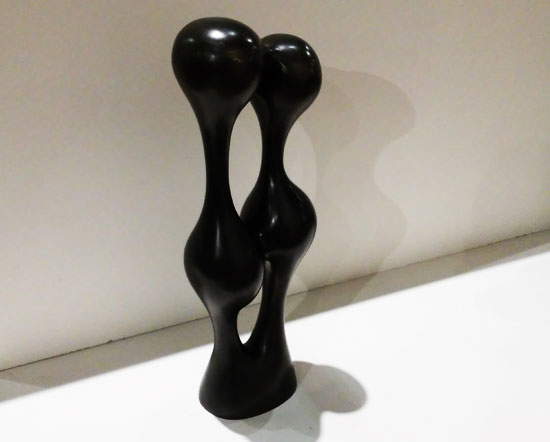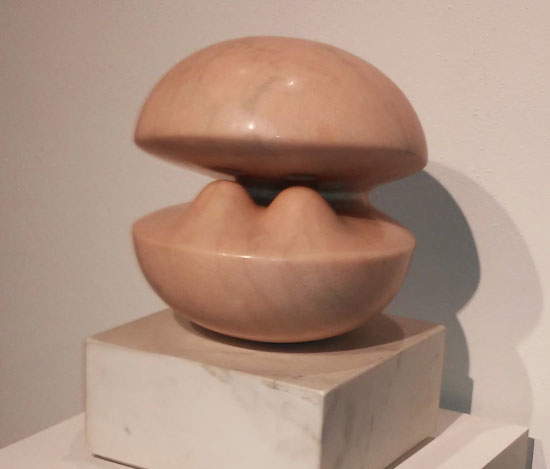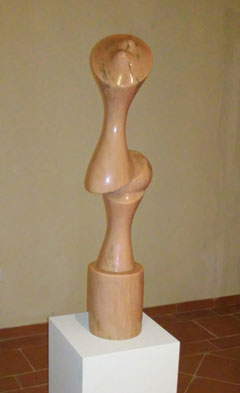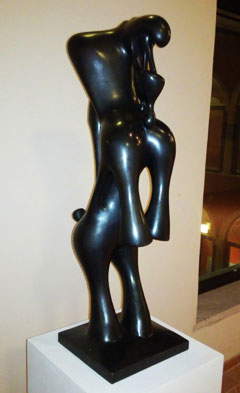To describe the imagery and art of the Cuban sculptor Agustín Cárdenas (1927 - 2001), it is possible to use a metaphor that is not new to his sculpture, but nonetheless effective. It is necessary to imagine making love to a woman (necessarily: Cárdenas’s sculpture is mostly female), in the dark, or at any rate with a soft light that barely illuminates the room, so that we cannot see the woman in front of us. It is also okay if we do it with our eyes closed. Of course, we have to imagine that she is completely naked, and we have to be mindful of that feeling of warmth mixed with pleasure that we feel as we gently furrow her body with our hands or mouth to taste the softness of her skin, the fullness of her form, the sweetness of her perfume: and with these sensations we build a kind of mental image of our woman, which proceeds by abstraction since, while making love to her, what we are least interested in are the details. This image renders, in broad strokes, the essence of Cárdenas’ sculpture.
A small bronze work of his from 1974, Le b aiser (“The Kiss”), helps make this impression explicit: two vaguely anthropomorphic figures are caught in a sensual kiss captured in its essence. The heads of the two figures are joined, just as their feet are joined at the base, inextricably. Seductive forms pregnant with eroticism, “swollen with a life force that from within presses expansively on the contours and ideally dilates them to the point where they become a testimony to the life and breath of the universe,” wrote art critic Luigi Carluccio after attending Cárdenas’ first exhibition in Italy. In fact, what strikes us, observing the Cuban sculptor’s works, is theintense vitality of his forms. They seem to us essential, and therefore closed, forms, but also pervaded by a soul that seems to give them strength, almost movement. “Nature, as Cárdenas sees it,” wrote French critic George Waldemar, “is not an exclusively physical phenomenon. He reveals the actual presence of elemental forces.” His forms “vibrate, quiver and throb, and are moved by the springs of the soul.” Evoking an earthly image, rather than making it visible: this is probably the highest sense of his art.
 |
| Agustín Cárdenas, Le baiser (1974; bronze) |
Under Cárdenas’s hands, marble, bronze, and wood, the materials he most often used, take on sinuous, voluptuous forms that hark back to anarchaic art: the Cuban sculptor was trained in the Paris of the Surrealists, where he moved in 1955 and where he found still working the artist who would become the main reference point for his art, Constantin Brancusi (1876 - 1957). From Brancusi, Cárdenas would derive, essentially, the artistic procedure: the elements of the natural world are stripped of the superfluous, in order to arrive, proceeding by geometric abstractions, at a completed and essential form, though not entirely abstract, in order to elevate the subject to a kind of perfection that gives it sacredness. But the substantial difference between Brancusi and Cárdenas lies in the fact that the Romanian sculptor favored forms symbolizing virility (columns, phalluses) while Cárdenas is decidedly more fascinated by the feminine universe. And compared to Brancusi, Cárdenas is a less “mystical” sculptor, we might say: the Cuban sculptor’s references are not to be sought in religion or mythology; Cárdenas’ references belong to the earthly world. This also explains the vivid sensuality of his forms. Although these earthly elements of his are imbued with thatprimitive animism filled with references to birth, motherhood, the parental force of the female and nature in the broadest sense. Hence the vivid eroticism of Cárdenas’ art: life is born from love, which in turn results in a physical act. Perhaps the most tangible sign of this quest are those two paired rounds, almost two small breasts that recur as a delicate fixation in his art: his Boule rose, a work from 1971, takes the form of a shell that unfolds and shows us the two breasts. Just as Greek mythology gave birth from the shell to Venus, thealma Venus, the “generating” Venus of Lucretius’ De rerum natura, so, more earthily and materially, Agustín Cárdenas’ Boule reveals to us the “elemental force” and palpitating life that is born in the form of two breasts.
 |
| Agustín Cárdenas, La boule rose (1971; pink marble). |
And if for the Surrealists an interest in anart with an ancestral flavor like African art was a way of exploring new artistic possibilities, for Cárdenas it was a kind of return to his origins: born in Matanzas, an important center of African-American culture in northern Cuba, Cárdenas was a descendant of African slaves deported to Cuba at the time of Spanish colonization. “I am a Negro of African descent, born in Cuba and adopted in Montparnasse,” Cárdenas reportedly said in an interview with a Venezuelan newspaper. His art cannot but have, therefore, a universal character, which refuses to be categorized under local schemes: it takes cues from Western art, does not forget the American past, and turns to African art. Cárdenas, however, gave evidence of imprinting his sculptures with a soul strongly marked by this search for his own African origins. And all this was taking place at a time when Paris was particularly attentive to the themes of which negritude, the cultural movement born precisely in Paris in the late 1940s, was the bearer: the emancipation of Africans and African-Americans, the vindication of their own cultural identities and origins, and the desire to establish equality between whites and blacks. For Jean-Paul Sartre, blackness is “the sperm of the world,” and closeness to nature, which often results in a strong sensual joy, is the very essence of Negro existence: a concept that aroused considerable controversy against Sartre’s thought as expressed in his Orphée noir, which was deeply inspired by Negritude. For the theme of closeness to nature could be understood in a negrophobic sense: the same criticism attracted Senegalese poet Léopold Senghor for his phrase “emotion is negro, reason is Hellenic.” But Senghor was merely distinguishing between an intuitive reason, proper to blacks, and a discursive reason, proper to whites. Likewise, Sartre was merely connoting, in an authentic and disinterested way, Negro poetics through a way of feeling the world that is particularly lyrical and close to the elements.
It is precisely on the basis of this lyricism that Cárdenas’ sculpture can also be read. His sensuality is proper to an artist who feels closeness to nature. And this closeness to nature and its elements is very often resolved in totemic forms, which are also linked to African art and its essentiality, sometimes not immediately receivable by the viewer of the Cuban sculptor’s works, but which nevertheless maintain a link with reality: this is what happens in African art, and this is what happens in several of Cárdenas’ works, such as Le repos du petit oiseau (“The Rest of the Little Bird”) or La fiancée du cheval (“The Girlfriend of the Horse”). The forms combine, pair up and eventually, as in a dream, create a profound harmony. And they are always pervaded by a remarkable life force. A harmony that, however, always has a universal significance: it has been said of how Cárdenas’ art cannot be reduced to local patterns, and is therefore an art with which everyone can come into direct contact, interpreting it also according to their own way of seeing, their own sensitivity. And it could not be otherwise for a sculptor linked to three continents: born in America, originally from Africa, moved to Europe. “I create forms in an unconscious way,” Cárdenas said again in the above interview, “as if they were part of an exercise or a constant search. They can therefore sometimes be ambiguous, for someone they may be figurative, for someone else abstract. Everyone can see in my sculpture what they want.”
 |
| Agustín Cárdenas, Le repos du petit oiseau (1981; pink marble) |
 |
| Agustín Cárdenas, La fiancée du cheval (1984; bronze) |

Warning: the translation into English of the original Italian article was created using automatic tools. We undertake to review all articles, but we do not guarantee the total absence of inaccuracies in the translation due to the program. You can find the original by clicking on the ITA button. If you find any mistake,please contact us.